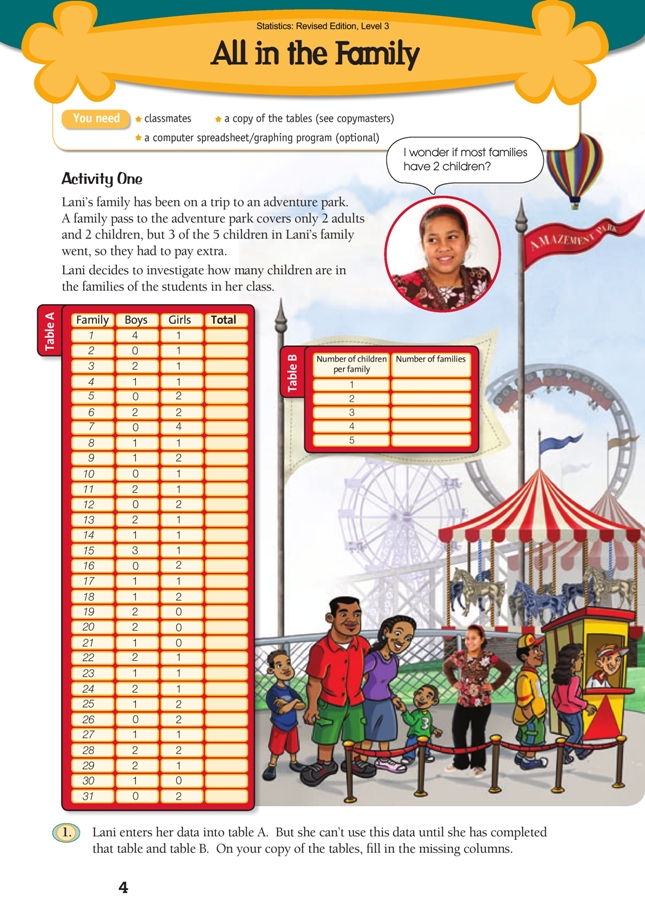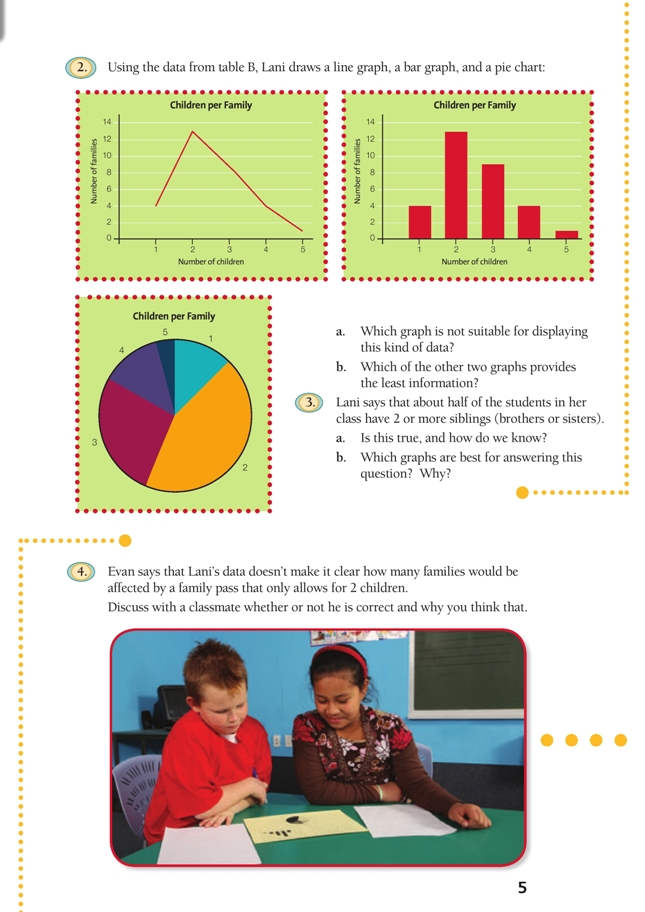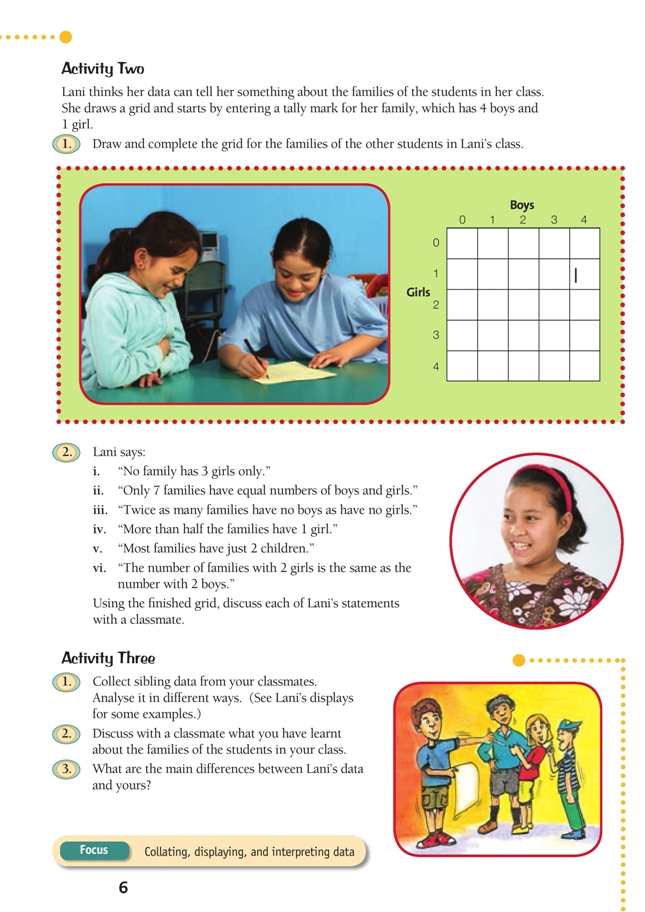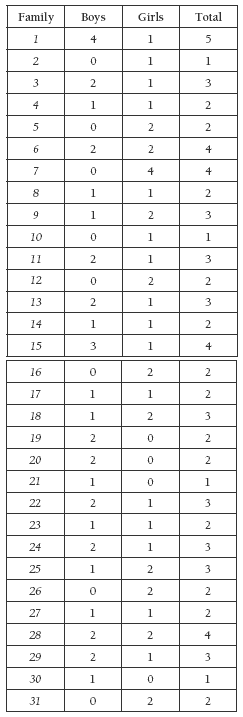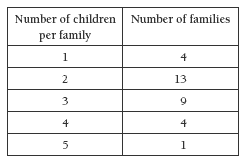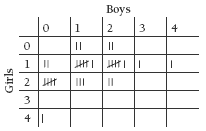This is a level 3 statistics activity from the Figure It Out series.
A PDF of the student activity is included.
Click on the image to enlarge it. Click again to close. Download PDF (1688 KB)
decide which graph is most suitable to represent the data
answer questions from a table
collect and display data
compare data groups and make conclusions
This diagram shows the areas of Statistics involved in this activity.
The bottom half of the diagram represents the 5 stages of the PPDAC (Problem, Plan, Data, Analysis, Conclusion) statistics investigation cycle.
Copy of the Tables (see Copymaster)
FIO, Level 3, Statistics Revised Edition, All in the Family, pages 4-6
A computer spreadsheet/graphing program (optional)
Activity One
In this activity, the students total the data in Table A and then summarise it in Table B so that deductions can be made. Three graphs are based on the information in Table B. Not all are equally suitable: the students need to realise that some graphs are better for certain types of information.
A line graph is inappropriate for this data because graphs of this type are most suited to showing trends in data over a period of time (with time on the horizontal axis). Line graphs should not be used for discrete data when there is no meaning that can be attached to non whole values on the horizontal axis (for example, a family with 2.7 children).
A bar graph shows the frequency or number of values in each category and how data is clustered or spread. In this case, the graph makes it clear that there are more 2-sibling families represented in the class than any other kind of family.
Pie charts show proportions visually. The pie chart shown makes it reasonably easy for students to estimate the fraction of the class that has a given number of siblings, but it does not show how many families fall into each category.
To answer question 3, students have to be able to make sense of the expression “two or more siblings”, which will be unfamiliar to some. In terms of the data, it means “three or more children” because the class member is included as part of his or her own family. Those not included in Lani’s statement are the families with two or fewer children.
Activity Two
This activity involves reorganising (or recategorising) data so that it can be analysed on the basis of family patterns and allow other features to become evident. This is possible because the data is multivariate (for each student, the data collected includes both number and gender). As part of their developing statistical literacy, students need to understand that grouping data (to create, for example, a pie chart or bar graph) always involves discarding potentially useful data. They also need to aim to collect multivariate data wherever possible because it can be analysed in more
and more interesting ways and it is able to tell more stories. Discuss with your students what other related data Lani could have easily collected at the same time as she collected the age and gender of the children in her classmates’ families. The most obvious is age. This would have made it possible to explore “place in family” patterns, for example, and it may have made it possible to better answer the original question relating to family passes.
Activity Three
This is a whole-class activity that will require your involvement in the planning. It could begin at the planning stage of the PPDAC cycle, given the preparation done in activities One and Two. Alternatively, the scope of the investigation could be broadened (perhaps by collecting age data as suggested above) and other questions answered, in which case students will need to begin at the problem stage of the investigation cycle. Data cards could be a useful tool for collecting the class data.
Ideally, students will have access to a computer spreadsheet/graphing program so that they can construct a range of graphs with ease. First check that your students have an adequate understanding of how to use the available spreadsheet programs.
Ensure that this activity does not just become a data-gathering and graphing exercise. The two final stages of the PPDAC cycle (Analysis and Conclusion) are the most important: what stories can this data tell us?
Answers to Activities
Activity One
1. Table A
Table B
2. a. The line graph because this data is discrete, not continuous. You can’t, for
example, have between 1 and 2 children in a family (for example, 112 children).
b. The pie chart. It doesn’t show the frequency (number of families).
3. a. Yes. 14 have 2 or more siblings, while 17 have 1 or no siblings. So you could say this is “about half”.
b. Either the bar graph or the pie chart. The relevant information is very clear in the
bar graph, and you can easily total the frequencies. It is also very clear in the pie
chart that families with 3 or more children account for just under half of the total.
4. Comments will vary, but should be based on a reasonable argument. The data collected does not include age, so some of the children that have been counted in the table may be regarded as “adults” and therefore not eligible for entry as “children” on a family pass. This may be what Evan had in mind.
Activity Two
1.
2. i. True. There are no tally marks in any of the columns for showing 3 girls.
ii. False. There are 6 families with 1 boy and 1 girl and 2 families with 2 boys and 2
girls. That is 8 families in all.
iii. True. There are 8 families with no boys and 4 families with no girls.
iv. True. Of the 31 families, 16 have only 1 girl.
v. False. 13 of the 31 families have just 2 children. This is less than half, not
“most”.
vi. True. 10 families have 2 boys, and 10 families have 2 girls.
Activity Three
1.–3. Data and conclusions will vary.
Key Competencies
All in the Family can be used to develop these key competencies:
• thinking
• using language, symbols, and texts
• participating and contributing
